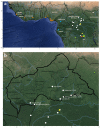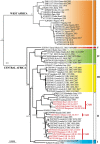Genomic history of human monkey pox infections in the Central African Republic between 2001 and 2018
- PMID: 34158533
- PMCID: PMC8219716
- DOI: 10.1038/s41598-021-92315-8
Genomic history of human monkey pox infections in the Central African Republic between 2001 and 2018
Abstract
Monkeypox is an emerging infectious disease, which has a clinical presentation similar to smallpox. In the two past decades, Central Africa has seen an increase in the frequency of cases, with many monkeypox virus (MPXV) isolates detected in the Democratic Republic of Congo (DRC) and the Central African Republic (CAR). To date, no complete MPXV viral genome has been published from the human cases identified in the CAR. The objective of this study was to sequence the full genome of 10 MPXV isolates collected during the CAR epidemics between 2001 and 2018 in order to determine their phylogenetic relationships among MPXV lineages previously described in Central Africa and West Africa. Our phylogenetic results indicate that the 10 CAR isolates belong to three lineages closely related to those found in DRC. The phylogenetic pattern shows that all of them emerged in the rainforest block of the Congo Basin. Since most human index cases in CAR occurred at the northern edge of western and eastern rainforests, transmissions from wild animals living in the rainforest is the most probable hypothesis. In addition, molecular dating estimates suggest that periods of intense political instability resulting in population movements within the country often associated also with increased poverty may have led to more frequent contact with host wild animals. The CAR socio-economic situation, armed conflicts and ecological disturbances will likely incite populations to interact more and more with wild animals and thus increase the risk of zoonotic spillover.
Conflict of interest statement
The authors declare no competing interests.
Figures



References
-
- Shchelkunov SN, Marennikova SS, Moyer RW. Orthopoxviruses Pathogenic for Humans. Springer; 2005. pp. 155–192.
Publication types
MeSH terms
LinkOut - more resources
Full Text Sources
Medical
Miscellaneous

